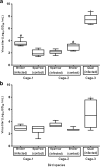Infectivity and transmissibility of H9N2 avian influenza virus in chickens and wild terrestrial birds
- PMID: 24134616
- PMCID: PMC4015117
- DOI: 10.1186/1297-9716-44-100
Infectivity and transmissibility of H9N2 avian influenza virus in chickens and wild terrestrial birds
Abstract
Genetic changes in avian influenza viruses influence their infectivity, virulence and transmission. Recently we identified a novel genotype of H9N2 viruses in widespread circulation in poultry in Pakistan that contained polymerases (PB2, PB1 and PA) and non-structural (NS) gene segments identical to highly pathogenic H7N3 viruses. Here, we investigated the potential of these viruses to cause disease and assessed the transmission capability of the virus within and between poultry and wild terrestrial avian species. Groups of broilers, layers, jungle fowl, quail, sparrows or crows were infected with a representative strain (A/chicken/UDL-01/08) of this H9N2 virus and then mixed with naïve birds of the same breed or species, or different species to examine transmission. With the exception of crows, all directly inoculated and contact birds showed clinical signs, varying in severity with quail showing the most pronounced clinical signs. Virus shedding was detected in all infected birds, with quail showing the greatest levels of virus secretion, but only very low levels of virus were found in directly infected crow samples. Efficient virus intra-species transmission was observed within each group with the exception of crows in which no evidence of transmission was seen. Interspecies transmission was examined between chickens and sparrows and vice versa and efficient transmission was seen in either direction. These results highlight the ease of spread of this group of H9N2 viruses between domesticated poultry and sparrows and show that sparrows need to be considered as a high risk species for transmitting H9N2 viruses between premises.
Figures

References
-
- King AMQ, Adams MJ, Carstens EB, Lefkowitz EJ. In: Virus Taxonomy, Ninth Report of the International Committee on Taxonomy of Viruses. King AMQ, Adams MJ, Carstens EB, Lefkowitz EJ, editor. San Diego: Elsevier Academic Press; 2012. Family Orthomyxoviridae; pp. 749–761.
-
- Tong S, Li Y, Rivailler P, Conrardy C, Castillo DA, Chen LM, Recuenco S, Ellison JA, Davis CT, York IA, Turmelle AS, Moran D, Rogers S, Shi M, Tao Y, Weil MR, Tang K, Rowe LA, Sammons S, Xu X, Frace M, Lindblade KA, Cox NJ, Anderson LJ, Rupprecht CE, Donis RO. A distinct lineage of influenza A virus from bats. Proc Natl Acad Sci U S A. 2012;44:4269–4274. - PMC - PubMed
-
- Brown IH. Summary of avian influenza activity in Europe, Asia, and Africa, 2006–2009. Avian Dis. 2010;44:187–193. - PubMed
-
- Fusaro A, Monne I, Salviato A, Valastro V, Schivo A, Amarin NM, Gonzalez C, Ismail MM, Al-Ankari AR, Al-Blowi MH, Khan OA, Maken Ali AS, Hedayati A, Garcia Garcia J, Ziay GM, Shoushtari A, Al Qahtani KN, Capua I, Holmes EC, Cattoli G. Phylogeography and evolutionary history of reassortant H9N2 viruses with potential human health implications. J Virol. 2011;44:8413–8421. - PMC - PubMed
-
- Alexander DJ. Report on avian influenza in the Eastern Hemisphere during 1997–2002. Avian Dis. 2003;44:792–797. - PubMed
Publication types
MeSH terms
Substances
Grants and funding
LinkOut - more resources
Full Text Sources
Other Literature Sources
Medical
Miscellaneous

